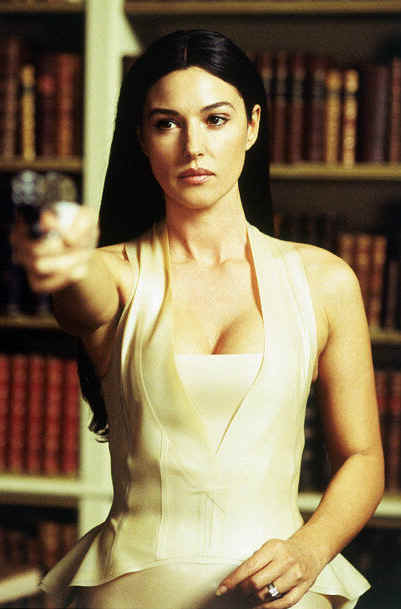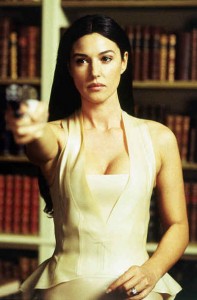
 Archival interview with Owen Paterson from the official Matrix website.
Archival interview with Owen Paterson from the official Matrix website.
MATRIX: Where are we right now?
OWEN: We are in the Temple from the Zion set, it’s a big set. Eventually there will be about 900 extras on this set, and we’re going to see a scene with Morpheus [Laurence Fishburne] preaching, or speaking, doing a great monologue to his audience, the people of Zion. We have to imagine that we are 4 or 5 miles below the top of the earth, so we are way down below the broadcast zone everyone is used to from the first film. We’re down at the very bottom of the Zion bottomless pit, in the Zion temple. We’re trying to achieve a church-like, or mosque-like feeling in this place, so we’re trying to light it in a very architectural way.
We had sketches of what we hoped it would look like drawn, then we built it in the computer in 3D. We put all the pillars exactly where we wanted to have them so that when you look towards the pulpit, where our actors will be, you can actually line everything up in a kind of organic, but also a sort of symmetrical, way. This is the most organic set that we will have in all the three movies. Most of them are nuts and bolts and Geof Darrow [Concept Illustrator] engineering, or MATRIX streets and clean lines. This set is our ode to organic things.
MATRIX: Compared to other sets on other films, this set must have been very high on the scale of challenge.
OWEN: This set is huge. It has taken a big team of American technicians to make this cave, it’s a huge construction. The set is made out of styrene foam, a lot of it, and polyurethane foam sprayed over the top of it. There has been an army of people carving the styrene foam, and then a number of people spraying urethane foam over the top of it to perfect the look. Then there’s a really big paint job, Joe [Hawthorne], our painter and his team, have put fantastic finishes on these sets, they really do look like rock. There are hero sections and not so hero sections, but in the real hero sections, the rock is perfect. There’s like a wet feeling where the water has been running down, and there’s a kind of clarity, a kind of clean line that lime stone gets in a cave.
We also have an added feature that Larry and Andy [Wachowski, Writers/Directors] like – The Journey to the Center of the Earth lava pits as well. The lava pit here looks a little bit blood red at the moment, but eventually it’ll be illuminated, and it will get crusty bits of lava on the top of it. In saying that this set is organic, I think Larry and Andy very much wanted it to be like Mother Nature, it’s a primeval thing, it’s almost like the womb. We’re close to the center of the earth, the stalactites are growing down and hopefully there’s a quality of growth and hope. It’s not a dank and cold place, it’s a place where you can be and you can sit, either tranquilly and meditate, or with your 200,000 friends, who will eventually populate this set. The parts we’ll see on film, that we can physically see today, are probably only an eighth of how big this cave really is.
Although we’ll have 900 extras here, eventually Zion has perhaps 200,000 as its population. To do that, John Gaeta and his Visual Effects team will extend the set back away from the pulpit down to the other end, for about the equivalent of half a mile. They’ll also add a lot of height to this, our set at the moment is only 30 feet high, but in reality it would be perhaps 300 feet high. Combining what’s physically been built by Butch [West, Construction Coordinator], his construction team, the carvers, and Mark Mansbridge [USA Art Director] and his team of people drafting all this up, they’ll add to that substantially in Visual Effects. So you’ll hopefully get this fantastic feeling of being in an enormous cathedral.
MATRIX: Right now we’re just a few days from filming on the Temple set.
OWEN: Yes, we’re just a few days from filming, they’re trimming all the lights and doing the last little pieces of preparation for physical effects, and the Art Department is dressing things. Over here on my right, there’s a big band section, where we’ve got some great instruments the Set Dressing Department made from some lovely drawings Simon Murton [Concept Illustrator] did. For set dressing like these instruments, we can’t use any wood, and we can’t use anything we can just go down to a shop and buy. So we’ve had a lot of people doing conceptual art on the film, trying to follow concepts from Larry and Andy and myself, about what we feel these pieces should be like. Simon drew these great instruments, which are kind of based around the sort of technology we know, and from what we’ll see in THE MATRIX films two and three on Zion – the pipes and the girders, and all that sort of stuff. They are really unique, they belong in an abstract museum, or a music museum at least. Some of them sound good, most of them sound terrible, but they look fabulous. The guys who built them have done a great job. It’s like they’ve taken the drawings and somehow, through some magical 3D photocopier, they’ve made them real.
MATRIX: How long has this set taken to build?
OWEN: Not that long actually. I suppose about a month and a half from when they really started. I’ve been backwards and forwards to Australia a number of times, (we’ve had our Art Department working back there), so I’ve seen it in various stages. From an empty stage they first set out, to the first few blocks put up, then I went back to Australia for two weeks, and when I came back here for two weeks, a lot had happened. I went back to Australia again for two weeks and it was just about finished when I came back, so it’s been a very rapid process. Quite a lot of man-hours have gone into it, quite a lot of people have worked on it, all of them have done a fantastic job.
There has been a combination of people to make this set work: from the people who draft it up, as I said, it was done in the computer, to the people who made a model of that, quite a sophisticated computer cut model. We had a lovely little cardboard model made of it as well, with all these contour lines. If anybody knows what a map looks like, a topography map, it was a bit like that, where every foot we had a contour, and we were able to plan out for all these pieces. When you look at the floor in here at the moment, it doesn’t look like a great deal because we haven’t put a great deal of effort into it, as eventually 99% of it will be covered with people. But we need to have a surface that people can dance on.
From those people who made the models it then came down to the construction guys, and then the sculptors. When the sculptors were finished, the foamers had to do their work, and then the painters, whose work really turned it from looking almost like an ice cave, into a limestone cave. And then the set decorators have to do their piece, creating candelabras and musical instruments. You’d think in a cave like this, or a temple, or a mosque type of set, there wouldn’t be a lot of set decorating, but it’s quite surprising. When you put all the pieces together, from lights they’ve needed to find that we can see on camera, to everything else, it’s pretty amazing.
MATRIX: As far the scale goes, there are going to be a lot of people on this set.
OWEN: There will probably be more in this set, than any other set. Eventually we will see this with visual effects, so we’ll see hundreds of thousands of people. On some of the other Zion sets which have walkways, we will put a group of perhaps 100 people on them in Australia, and they’ll walk along that, then eventually the visual effects team will make that appear to be many more. We’ve got some interesting things happening, we’ve got some big events happening. A lot of people are making their way from their homes in Zion in the bottomless pit, they’re making their way here, into their last sanctuary.
MATRIX: We’ll see a lot more of Zion, which will be filmed in Australia; how tricky is that to orchestrate? For instance, the entrance way is being built in Australia.
OWEN: It’s interesting. We have two entrances, in a sense, in the cave. We have built a small entrance here in the US, the idea being that we can bring our kid in who has to run in at the beginning of the film, after Councilor Hamann has done his dialogue piece. In that scene we need to be able to see 900 people, as many extras as we can possibly get. So what Larry and Andy have asked us to do is have kind of a secondary entrance in here, and in Australia we will build another entrance, where we’ll have some other scenes where we don’t need quite so many people, but will have similar dressings. So, for a later scene in Australia, we have put defensive type dressing up here, with guns and barricades. We’ll use those again and make more of them for the set in Australia. We’ll take parts of the walls and some of the stalactites, so we can hopefully get all of the colors and the textures the same in Australia. Working on two continents is an interesting process.
MATRIX: How many times have you been back and forth between Australia and the United States?
OWEN: In the last year I’ve done about 12 round trips. In the last 14 months I think I’ve done about 16 round trips, because I came over here a few times before I actually started working over here in June [2000]. I think this is the last time on this film that I have to come over to America, not that I haven’t enjoyed America, it has been fantastic, but my family and I will enjoy me being at home for a while. It’s been a long haul, it’s been harder perhaps for them in Australia than it has for me, luckily I’ve got many friends here in America, but it’s been quite hard to be so far away.
It seems like it should be terrific because you’re in America, and you’re here for like 12 days, then you get on an airplane and fly back to Australia, and you’re there for 12 days, or maybe 14 days, then you get on an airplane and you fly back. Once you’ve done that two or three times, the gloss of it wears off, and you begin to suffer. When you fly from the west to the east, it’s particularly difficult, and it takes me two or three days to reacclimatize. And of course, when you travel back to Australia from here, you automatically lose a day, if I leave on a Wednesday, I don’t arrive till Friday morning. It’s quite an interesting exercise.
MATRIX: Thanks Owen.
Interview by REDPILL
June 2001

Be the first to comment